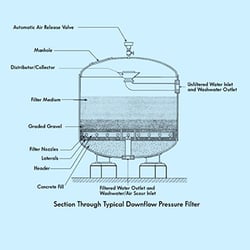 In water treatment, it is often required to remove small particulate matter from the raw water.
In water treatment, it is often required to remove small particulate matter from the raw water.
One of the most cost-effective ways to accomplish this is with a pressure filter. Sometimes referred to as “sand filters,” a pressure filter consists of a rigid filter vessel capable of withstanding internal pressure, combined with pipework to distribute and collect water and one or multiple types of filter media. Pressure filters are commonly used in municipal water systems, industrial facilities, residential well water systems, and swimming pools. Typical pressure filter construction is shown below:
At the top of the filter vessel, a distributor is used to break up and distribute the water flow so that there are no concentrated flow jets that stir up the media bed. Inflow distributors are usually oriented to direct flow at the top of the vessel to disperse the flow further. Below the distributor is the primary filter bed. The filter bed contains fine-grained media, most often sand, including crushed anthracite coal, activated charcoal, garnet, or other granular bulk products. The media bed is the thickest layer in the filter vessel and is the region that does the actual filtering of the water or other fluid. Below the media bed will be one or more support layers. These will usually be larger-sized gravel that is chosen to support the filter bed while allowing high flow through the support layer and into the outflow header. The outflow header can take several forms but is often composed of a large central pipe with multiple smaller pipes or “laterals” attached. The laterals are slotted or perforated. This allows the pressurized water to flow into the laterals and out through the outflow header into the downstream components of the water treatment system.
The most common media used in pressure filters is silica sand.
Sand is cost-effective, long-lasting, and suitable for most applications. For applications where maximum clarity is required, crushed anthracite coal is used. Anthracite filter media is more expensive, but the grains are more jagged and randomly oriented than sand, which allows it to trap even finer particles. Crushed garnet is similar in structure and application to both silica sand and anthracite, but it is much denser, which allows it to be back-washed at a higher rate (more on that later). There are also media types tailored to remove non-particulate contamination. These are activated carbon and greensand. Activated carbon is a granular open-structured charcoal product that has micro-pores covering each grain of media. These pores trap organic compounds such as VOCs, oils, and solvents. Greensand is the name for sand that has been coated with manganese dioxide. Greensand media is used to remove iron, manganese, hydrogen sulfide, arsenic, and radium from water, as well as filter particulates. Pressure filters can be made with one media type or multiple types of media in layers. A filter with more than one media type is called a “multimedia filter.”
Regardless of the media used in the pressure filter, the method of filtration is the same.
Particulate matter in the water gets trapped among the grains of filter media and accumulates. As the water moves through the bed from top to bottom, particulates are deposited in the bed. Over time the particulates accumulate to the point where the flow of water is impeded, and increased pressure is needed to drive the same flow. When the filter reaches this point, the filter is cleaned using a process called “backwashing”. During backwashing, the flow through the filter is reversed, and clean water is pumped in through the bottom of the filter and out through the top, where it is discharged to a wastewater system. During the backwash operation, previously captured particulates are freed from the media bed granules and become suspended in the backwash water. A typical backwash cycle lasts several minutes and can be considered complete when the backwash flow runs nearly clear. At the conclusion of a backwash operation, the flow is returned to the original top-down direction, and the filter is ready to run again. This ability to continually clean and renew the bed is what makes pressure filters very cost-effective to operate. The media in the filter can last for millions of gallons, often over years of operation before the media needs to be changed.
Pressure filters are robust devices that can run for many years with minimal maintenance overhead.
Especially when combined with automated control systems, actuated valves, and pump controls. A modern pressure filter can provide clean, filtered water to be used as-is or sent to downstream equipment for further refinement. It is essential to have a qualified engineer or manufacturer to design a system for your application. Once sized and installed, a pressure filter system can provide near endlessly renewable performance with a lower price point and operational cost than most other options. If you have any questions or need help with a project or assistance selecting the right pressure filter for your project, please feel free to contact the professionals at DeLoach Industries, Inc. at 941-371-4995.




